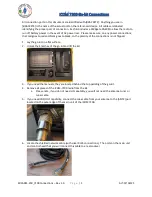
65-2443 PPM Hydrogen Transmitter • 13
Maintenance
This section describes maintenance procedures. It includes preventive maintenance, troubleshooting,
and component replacement procedures.
Preventive Maintenance
This section describes a preventive maintenance schedule to ensure the optimum performance of the
ppm hydrogen transmitter. It includes daily and quarterly procedures.
Daily
Verify a display reading of 0 ppm at the controller. Investigate significant changes in the display
reading.
Biannual
Calibrate the ppm hydrogen transmitter as described on page 16.
Troubleshooting
The troubleshooting guide describes symptoms, probable causes, and recommended action for
problems you may encounter with the ppm hydrogen transmitter.
NOTE:
This troubleshooting guide describes transmitter problems only. See the controller operator’s
manual for problems you may encounter with the controller.
Table 2:Troubleshooting the ppm Hydrogen Transmitter
Condition
Symptom(s)
Probable Causes
Recommended Action
Fail
Condition
• Controller indicates
a fail condition.
• The transmitter
wiring is
disconnected or
misconnected.
• The transmitter is
malfunctioning.
1. Verify that the transmitter wiring
is correct and secure.
2. Calibrate the transmitter.
3. If the fail condition continues,
replace the detector.
4. If the fail condition continues,
contact RKI for further
instruction.
Slow or No
Response/
Difficult or
Unable to
Calibrate
• Unable to accurately
set the span or
linearizing response
during calibration.
• Transmitter requires
frequent calibration.
Note:
Under “normal”
circumstances, the
transmitter requires
calibration once every
6 months.
Some applications may
require a more
frequent calibration
schedule.
• The calibration
cylinder is low,
out-dated, or
defective.
• The calibration
gas flow rate is too
low.
• The transmitter is
malfunctioning.
1. Verify that the calibration
cylinder contains an adequate
supply of gas.
2. Verify that the regulator used for
calibration is a 0.5 LPM
regulator.
3. If the calibration/response
difficulties continue, replace the
detector.
4. If the calibration/response
difficulties continue, contact
RKI for further instruction.


































